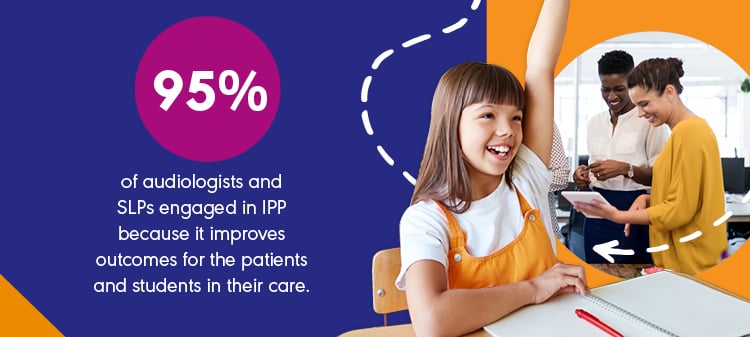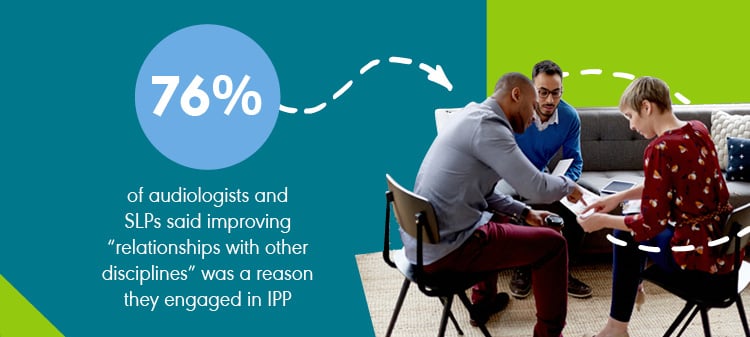Benefits of IPE and IPP
The main benefit of interprofessional practice (IPP) is that it improves outcomes for the people we serve. In fact, that’s the reason nearly 95% of audiologists and speech-language pathologists (SLPs) gave for practicing IPP when asked in a recent survey.
Interprofessional education (IPE) is equally as important. Working on a team involves skills that audiologists and SLPs need to learn. Through classes and professional development opportunities, IPE helps students and working professionals develop the skills to work on IPP teams.
The vast majority of audiologists and SLPs in a school, hospital, or private clinic think that IPP improves care and outcomes. The exact benefits differ depending on whether you work in health care or education settings. Watch this video to learn how interprofessional education and practice leads to better care, better outcomes, and better clinician satisfaction.
Benefits in Health Care
In health care settings, a move toward interprofessional teams is an important part of the transition to value-based care, which pays for value and results rather than volume of services delivered. IPP plays a huge role in helping medical teams become more efficient.
In order to make this new payment model a success, health care professionals—including audiologists and speech-language pathologists— need to collaborate. IPP helps them better coordinate services and track patient outcomes. IPP teams are critical to reducing gaps in patient care, lessening the opportunity for clinical errors and redundant services.
“We were so blessed to have an amazing team of professionals . . . It was a comfort to us to know that they were working together and talking to each other. We knew they knew what was going on and had his best interests at heart.”
Anne, speaking about her husband’s experience with a team of health care professionals
IPP, Health Equity, and Communication Access
IPP teams can play a key role in advocating for equitable health care for the people we serve and promoting communication access for individuals with communication disorders.
Health disparities are a major problem in the United States. Despite spending 17.8% of our gross domestic product on health care—a significantly higher percentage than in other developed countries—we continue to have worse outcomes. Factors such as social determinants of health impact health equity and Americans’ access to health care—including audiology and speech-language services. Learn more about inequities in the communication sciences and disorders in this ASHA Voices podcast.
However, interprofessional teams can play a key role in identifying issues and advocating for the systematic change needed to address them. IPP teams can help address equal access to audiology and speech-language services by identifying issues and advocating for change. ASHA’s Communication ACCESS initiative, Better Health Starts With Effective Communication, identifies six core principles to improve effective communication access in health services and programs. A communication access website serves as a hub for educational information and resources, infusing health equity and the social determinants of health.
In these case studies, explore examples of how interprofessional teams worked to advocate for health equity by recruiting a diverse class of graduate students, providing services to migrant farmworkers and their families, and expanding health care access among the LGBTQ+ veterans.
Working independently, health professionals do not have the time, skills, or resources needed to make major changes, writes Dr. Cynthia Haq in “The Path to Health Equity in Multidisciplinary Collaboration.” Instead, this requires collaboration across health care and social systems. Interprofessional teams can develop and advocate for solutions that surpass treating a single patient or working with an individual student. It’s through these partnerships that we can have a systems-level and population health impact—for example, by providing outreach to underserved populations or advocating for policy changes.
“Promoting health equity requires collaboration among key stakeholders in health and social systems; developing strategic partnerships; and engaging across institutional boundaries to identify local needs, promote best practices, and establish monitoring and evaluation to ensure these efforts are mutually beneficial and sustainable over time.”
Dr. Cynthia Haq
Benefits in Schools
For audiologists and SLPs in a school setting, IPP streamlines the process of planning and developing solutions for our students. The IPP framework ensures that assessments, teaching, and intervention methods of each team member—from classroom teachers to physical therapists to SLPs and special education teachers—are incorporated into our plans and work with students. Through collaboration, IPP teams help students achieve their individualized education program (IEP) goals—which in turn, leads to better performance in the classroom and sets up students for academic success.
This video features two people sharing their positive experiences working with collaborative teams of health care and education professionals. Their satisfaction is a direct by-product of well-orchestrated and effective interprofessional collaboration.
IPP Benefits Audiologists and SLPs, Too
Improving the quality of care for our patients and students isn’t the only advantage to participating in IPP. As audiologists and SLPs, we benefit, too.
ASHA members who use IPP found that the approach helps them demonstrate their value and expertise as audiologists and as SLPs. In fact, more than 75% of respondents to ASHA’s recent survey about IPP said that “improving relationships with other disciplines” was a reason they engaged in IPP. Survey participants also listed “reducing stress” and “advancing their professional skills” as key reasons for engaging in IPP.
In a health care setting, IPP teams that include audiologists and SLPs help other health care professionals—such as primary care physicians—to better understand their patients’ communication needs. Asking a patient about their communication needs FIRST can improve health care interactions and outcomes for patients, care partners, providers, and payers. Better health starts with effective communication. This increased understanding clarifies the unique expertise our professions provide and can translate into more referrals and inclusion on IPP teams to utilize our knowledge and skills.
In a school setting, IPP teams help SLPs build trust with colleagues. In fact, in ASHA’s recent survey about IPP, nearly 75% of SLPs working in schools said that IPP teams improved their relationships with other disciplines. Supporting each other ultimately results in students having a more comprehensive educational experience.
Benefits in a College/University Setting
In order to be successful in their careers, students need to develop the skills to work on IPP teams. That’s where Interprofessional education (IPE) comes in.
When professors of audiology and speech-language pathology incorporate IPE into their curriculum, they better prepare their students for careers in the evolving fields of education and health care. Students who graduate with the ability to collaborate with other disciplines will find themselves more prepared for their careers. This is ultimately a benefit to universities, too. Students’ success reflects well on educators and their academic programs.
What Happens When Professionals Don’t Engage in IPP?
When health care and education professionals don’t work as an IPP team, it impacts the people we serve.
When teams do not communicate effectively, patients, students, and their families can end up caught in the middle, passed between various professionals. These silos result in gaps in care, diagnostic errors, redundancy in services, and overbilling of services. Patients often waste time and money seeing multiple specialists—and still don’t get the help they need.
“If the professionals I saw collaborated together, it would have saved me money, time and it would have saved me some sanity as well.”
Carmen, patient seeking help for back and neck pain
“I felt there was a lack of communication with all the different people that we were talking to...it was almost like a Venn diagram, and I was trying to figure from all these people what was overlapping. I was trying to figure out who I should be talking to and who should be talking.”
Jill, mother seeking help for young son
In this video, interviewees describe their frustrations with ineffective interprofessional collaboration—or complete lack thereof. They express needing to advocate for themselves or family members because, without high-quality IPP teams, the health care professionals have failed to communicate effectively—and this can have a profound impact on the patient and/or their family.
 The main benefit of interprofessional practice (IPP) is that it improves outcomes for the people we serve. In fact, that’s the reason nearly 95% of audiologists and speech-language pathologists (SLPs) gave for practicing IPP when asked in a
The main benefit of interprofessional practice (IPP) is that it improves outcomes for the people we serve. In fact, that’s the reason nearly 95% of audiologists and speech-language pathologists (SLPs) gave for practicing IPP when asked in a 










